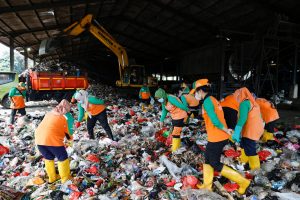By Sheldeen Joy Talavera, Reporter
WASTE-TO-ENERGY (WTE) projects involve trade-offs between disposing of waste and raising emissions levels, though the severity of the Philippines’ energy problems means all technologies must be considered, analysts said.
“Any legislation that seeks to increase the number of technologies which can respond to our energy demand needs to be supported,” Terry L. Ridon, a public investment analyst and convenor of InfraWatch PH, said via Viber.
Mr. Ridon said that allowing waste incineration facilities may “impact the country’s commitments to the Paris climate accord,” and is not consistent with the government policy of not allowing new coal-fired power plants.
“Waste incineration facilities produce significant emissions. This contradicts the policy direction of limiting emissions made by coal-fired power plants,” he said.
Gerry C. Arances, convenor of Power for People Coalition, said that WTE is “the wrong way to address the problem of solid waste.
“It encourages more waste for fuel use while ignoring the urgency of improving waste management and reduction,” he said via Viber.
“Pollution from incineration is also concerning, and would be a step backward in the global fight to curb emissions and improve air quality,” he added.
Pedro H. Maniego, senior policy advisor of Institute for Climate and Sustainable Cities, said that the Philippines needs to harness WTE projects “to address the twin problems of garbage and lack of power supply.”
Mr. Maniego said Republic Act (RA) No. 9003 or the Ecological Solid Management Act of 2000 was supposed to solve the garbage problem, but most local government units (LGUs) failed to implement the plans and programs called for under the law.
He said that many projects did not go ahead due to the ban on incineration imposed under RA 8749 or the Clean Air Act of 1999 and “failure to secure approval from LGUs.”
“Biomass is considered a renewable energy source because its inherent energy comes from the sun, and because it can regrow in a relatively short time. Its net GHG (greenhouse gas) emissions is zero compared to when the biomass are allowed to just decay,” he said.
The Department of Energy (DoE) described waste-to-energy as “an energy system with a process of converting WTE feedstock with various technologies, usually the conversion of non-recyclable waste materials into usable heat, electricity, or fuel through a variety of processes.”
A waste-to-energy bill is among the priority bills identified by the Legislative-Executive Development Advisory Council.
In 2023, Senate Bill No. 2267 or the proposed Waste-to-Energy Act reached the Senate plenary.
The DoE supports the objectives of the proposed law and intends to draft a framework by which WTE technologies may be harnessed for energy while generating revenue.
The DoE cited the need to strengthen and provide legislative structure to attract more investors, addressing both the need to manage disposal of municipal solid waste and add to the available sustainable energy sources.
“The DoE encourages the development of WTE technologies, provided that toxic emissions coming from WTE plants are properly addressed through state-of-the-art emission control and capture technologies with continuous emission monitoring system and ensure compliance to relevant environmental laws, rules and regulations set for the establishment and operation of WTE facilities,” the DoE said.
